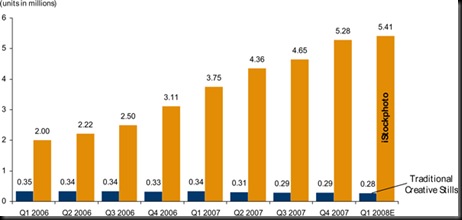As part of filings made with the SEC, Getty has had to disclose some information which it would normally keep secret.
One interesting quote is:
"The introduction of microstock has significantly increased the availability and usage of stock imagery. The advent of affordable high-end digital cameras and broadband Internet access has enabled semi-professional and hobbyist photographers to greatly expand the supply of digital stock imagery, and low microstock prices have put stock images within reach of far more potential customers. The primary consequence of the introduction of microstock has been to open the creative stock imagery market to new segments of users. Small and medium-sized businesses represent a large customer segment for which stock imagery was previously too expensive. For example, a dental practice might now include a microstock image of a boy brushing his teeth on its mailers to patients, whereas before it might have only shown a drawing of a tooth and toothbrush (or perhaps just a message in formatted text) on its appointment reminders because of the relatively high cost of stock imagery. Microstock also enables traditional stock image users to cost-effectively use stock images for interim uses such as storyboarding, customer pitches and internal presentations. Previously these applications would have contained lower quality, freely available images, or hand-drawn sketches. Customer research suggests that approximately 40-50% of microstock demand is comprised of entirely new end-uses, such as those described above. As a result of the combination of new customer segments and new end uses, volumes of microstock images are 15-20x greater than traditional stills.
Another interesting part is a comparison of sales volume between Getty and iStock, the market leader of macrostock and microstock respectively:

More details at this article from pdn.
The filings at the SEC are found here.





 The NZ government put out a brochure today setting out the benefits of its latest budget.
The NZ government put out a brochure today setting out the benefits of its latest budget.






